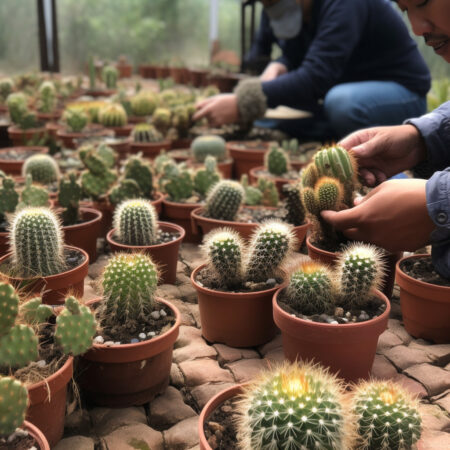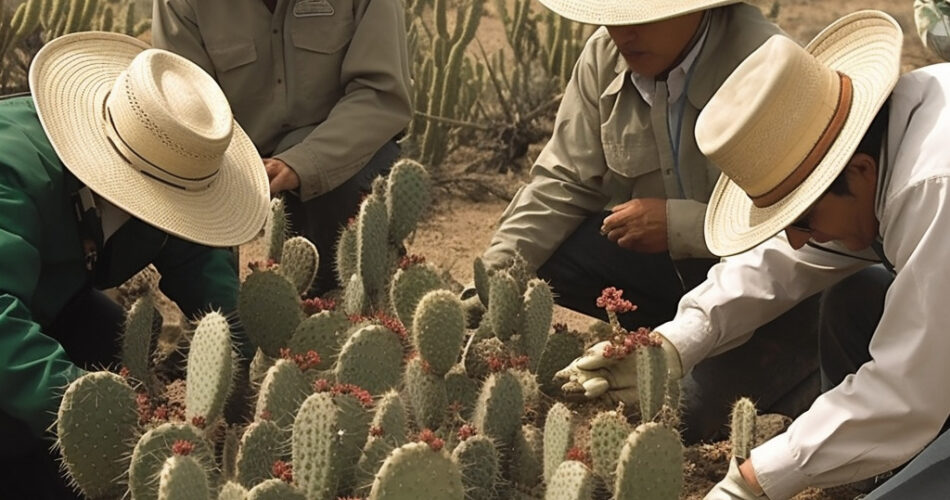Key Takeaways:
- Cacti support biodiversity by providing habitat and food for animals.
- Many cactus species are endangered, necessitating conservation efforts.
- Cacti play a vital role in preserving ecosystems by preventing soil erosion and surviving in water-scarce environments.
- Cacti can be cultivated for sustainable food production, offering nutrition and health benefits.
- Innovative farming techniques like hydroponics and genetic modification enhance cactus viability as a crop.
- Cacti can be used for biofuel production, offering a renewable alternative to fossil fuels.
- Collaboration between conservation organizations and agricultural communities is crucial for cactus conservation.
- Sharing knowledge and promoting awareness are important for sustainable cactus practices.
- Research, policy initiatives, and cactus-based industries contribute to the future of cactus conservation and agriculture.
The Importance of Cactus Conservation
Cacti, with their unique and iconic shapes, play a crucial role in supporting biodiversity and preserving ecosystems. These resilient plants have adapted to survive in arid and harsh environments, making them essential in maintaining the balance of delicate ecosystems around the world.
1. The role of cacti in supporting biodiversity
Cacti provide a habitat and food source for a wide range of animals, including birds, insects, and mammals. Many species rely on cacti for shelter, nesting sites, and as a source of water in arid regions. The spines of cacti also act as a deterrent against herbivores, protecting other plant species in the ecosystem.
2. Rare and endangered cactus species
Unfortunately, many cactus species are facing the threat of extinction due to habitat loss, illegal collection, and climate change. The International Union for Conservation of Nature (IUCN) has listed numerous cactus species as critically endangered or vulnerable, highlighting the urgent need for conservation efforts.
3. The significance of cacti in preserving ecosystems
Cacti have a remarkable ability to adapt to extreme conditions, making them vital in preserving fragile ecosystems. Their deep root systems help prevent soil erosion, while their ability to store water allows them to survive in water-scarce environments. By preserving cacti populations, we can ensure the health and resilience of ecosystems worldwide.
Agricultural Innovations for Cactus Sustainability
Recognizing the importance of cacti, agricultural innovators have been exploring ways to cultivate cacti for sustainable food production, as well as utilizing them for biofuel production.
1. Cultivating cacti for sustainable food production
Cacti, such as the Prickly pear (Opuntia species), have been cultivated for centuries as a source of food in arid regions. These plants offer various edible parts, including their fruits, stems, and even their flowers. Cactus fruits are not only nutritious but also have potential health benefits, containing high levels of antioxidants and fiber. With proper cultivation techniques, cacti can provide a sustainable source of food, particularly in regions where traditional agriculture is challenging.
2. Innovative farming techniques for cactus cultivation
To maximize the potential of cactus cultivation, innovative farming techniques have been developed. One such technique is hydroponics, which allows cacti to be grown in nutrient-rich water solutions without the need for soil. This method conserves water, reduces the risk of pests and diseases, and enables year-round production. Additionally, researchers are exploring genetic modification techniques to enhance the nutritional content and drought tolerance of cacti, further improving their viability as a sustainable crop.
3. Utilizing cacti for biofuel production
Cacti are a promising source of biofuel due to their high water-use efficiency and ability to thrive in dry conditions. Certain species, such as the prickly pear and the Agave, contain high levels of sugars, which can be converted into bioethanol through fermentation. Biofuels derived from cacti offer a renewable alternative to fossil fuels and have the potential to reduce greenhouse gas emissions.

Collaborative Efforts in Cactus Conservation and Agriculture
To ensure the long-term preservation and sustainable cultivation of cacti, collaborative efforts between conservation organizations and agricultural communities are crucial.
1. Partnerships between conservation organizations and agricultural communities
Conservation organizations and agricultural communities can work together to protect cacti habitats, implement sustainable farming practices, and raise awareness about the importance of cactus conservation. By establishing partnerships, these stakeholders can leverage their expertise and resources to develop practical solutions for the conservation and sustainable use of cacti.
2. Sharing knowledge and resources for sustainable cactus practices
Knowledge sharing is essential for promoting sustainable cactus practices. Farmers and scientists can exchange information about cultivation techniques, pest management strategies, and best practices for soil and water conservation. By harnessing collective knowledge and expertise, stakeholders can optimize cactus production while minimizing environmental impact.
3. Promoting awareness and education about cactus conservation and agriculture
Education and awareness play a vital role in fostering a culture of cactus conservation and sustainable agriculture. By educating local communities, consumers, and policymakers about the value of cacti and the potential of sustainable farming practices, we can foster appreciation and support for these initiatives. Furthermore, incorporating cactus conservation and sustainable agriculture into educational curricula can inspire the next generation of environmental stewards.
The Future of Cactus Conservation and Agriculture
The future of cactus conservation and agriculture holds promising prospects for both environmental sustainability and economic growth.
1. Research and development for improving cactus cultivation and conservation
Ongoing research and development efforts are focused on enhancing cactus cultivation techniques, identifying species with high commercial value, and developing conservation strategies. By investing in scientific research, we can unlock the full potential of cacti and ensure their long-term survival.
2. Policy initiatives and regulations supporting sustainable cactus practices
To promote sustainable cactus practices, governments and international bodies can implement policies and regulations that support conservation efforts and incentivize farmers to adopt sustainable farming techniques. By providing financial incentives, technical support, and access to markets, policymakers can create an enabling environment for sustainable cactus agriculture.
3. The potential of cactus-based industries in promoting economic growth and environmental stewardship
Cactus-based industries, such as the production of cactus-based foods, beverages, cosmetics, and biofuel, have the potential to generate economic growth while promoting environmental stewardship. These industries can create jobs, contribute to local economies, and reduce dependence on non-renewable resources. By embracing cactus-based industries, communities can achieve sustainable development and enhance their resilience to climate change.
FAQ
Question: What is the role of cacti in supporting biodiversity?
Cacti provide a habitat and food source for a wide range of animals, including birds, insects, and mammals. Many species rely on cacti for shelter, nesting sites, and as a source of water in arid regions. The spines of cacti also act as a deterrent against herbivores, protecting other plant species in the ecosystem.
Question: What is the significance of cacti in preserving ecosystems?
Cacti have a remarkable ability to adapt to extreme conditions, making them vital in preserving fragile ecosystems. Their deep root systems help prevent soil erosion, while their ability to store water allows them to survive in water-scarce environments. By preserving cacti populations, we can ensure the health and resilience of ecosystems worldwide.
Question: How can cacti be cultivated for sustainable food production?
Cacti, such as the prickly pear (Opuntia species), have been cultivated for centuries as a source of food in arid regions. These plants offer various edible parts, including their fruits, stems, and even their flowers. Cactus fruits are not only nutritious but also have potential health benefits, containing high levels of antioxidants and fiber. With proper cultivation techniques, cacti can provide a sustainable source of food, particularly in regions where traditional agriculture is challenging.
Question: What are some innovative farming techniques for cactus cultivation?
To maximize the potential of cactus cultivation, innovative farming techniques have been developed. One such technique is hydroponics, which allows cacti to be grown in nutrient-rich water solutions without the need for soil. This method conserves water, reduces the risk of pests and diseases, and enables year-round production. Additionally, researchers are exploring genetic modification techniques to enhance the nutritional content and drought tolerance of cacti, further improving their viability as a sustainable crop.
Question: How can cacti be utilized for biofuel production?
Cacti are a promising source of biofuel due to their high water-use efficiency and ability to thrive in dry conditions. Certain species, such as the prickly pear and the Agave, contain high levels of sugars, which can be converted into bioethanol through fermentation. Biofuels derived from cacti offer a renewable alternative to fossil fuels and have the potential to reduce greenhouse gas emissions.
Question: Why is collaboration between conservation organizations and agricultural communities crucial in cactus conservation?
Conservation organizations and agricultural communities can work together to protect cacti habitats, implement sustainable farming practices, and raise awareness about the importance of cactus conservation. By establishing partnerships, these stakeholders can leverage their expertise and resources to develop practical solutions for the conservation and sustainable use of cacti.
Question: How can knowledge sharing contribute to sustainable cactus practices?
Knowledge sharing is essential for promoting sustainable cactus practices. Farmers and scientists can exchange information about cultivation techniques, pest management strategies, and best practices for soil and water conservation. By harnessing collective knowledge and expertise, stakeholders can optimize cactus production while minimizing environmental impact.
Question: What is the future of cactus conservation and agriculture?
The future of cactus conservation and agriculture holds promising prospects for both environmental sustainability and economic growth. Ongoing research and development efforts are focused on enhancing cactus cultivation techniques, identifying species with high commercial value, and developing conservation strategies. By investing in scientific research, policies supporting sustainable farming, and embracing cactus-based industries, we can ensure the long-term survival of cacti while promoting economic growth and environmental stewardship.
Elia Martinez
Elia Martinez, Ph.D., is a celebrated Cactologist and author with over 20 years of experience in studying and cultivating cacti. Chief Editor of Cactus Classification, Elia is passionate about unraveling the mysteries of cactus biology and sharing this knowledge with gardeners and enthusiasts worldwide, making cactus care accessible and enjoyable for all.



Comments